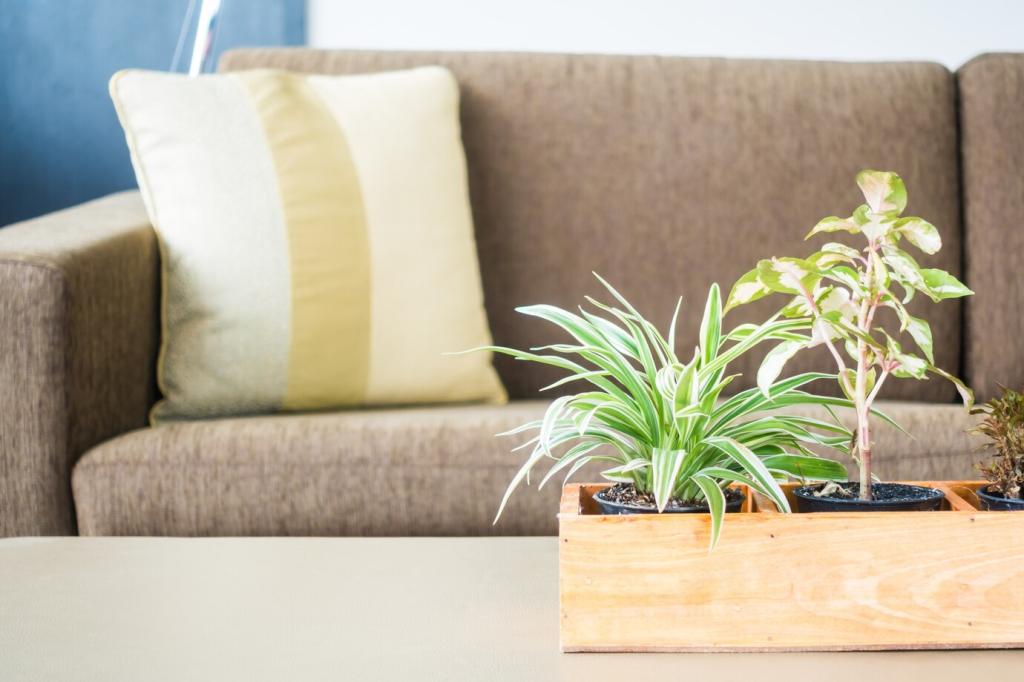The year 2024 marks a pivotal moment in the evolution of sustainable materials, as industries worldwide accelerate efforts to reduce environmental impact, combat climate change, and optimize resource use. From construction to fashion and beyond, innovative solutions are emerging to address the ecological footprint of conventional materials. This web page explores the leading trends, processes, and breakthroughs in sustainable material innovations for 2024, offering insights into how these advancements are reshaping the future of manufacturing, design, and environmental stewardship.
Circular Economy in Material Design
Recyclable polymers have emerged as a game changer in reducing plastic waste, with advanced versions now boasting similar or superior properties to their conventional counterparts. Unlike earlier plastics that could only be downcycled into lower-value materials, today’s recyclable polymers are engineered for multiple reuse cycles without significant degradation in quality. Businesses are increasingly implementing closed-loop recycling programs, where used products are reclaimed, broken down, and reconstituted into new goods—helping to close the materials loop. In 2024, research and commercial adoption focus on scaling up infrastructure for collection and processing, making these materials integral to everyday items like packaging, automotive components, and consumer electronics. The ongoing developments not only promise reduced landfill waste but also a significant decrease in carbon emissions and fossil fuel reliance.

Advanced Bio-Based Materials
01
Algae-Derived Plastics
Algae-derived plastics have witnessed a surge in investment and commercialization due to their numerous ecological advantages. Unlike crops such as corn or sugarcane, algae do not compete with food production and can thrive in a variety of environments, including brackish or wastewater. In 2024, these plastics are being used in everything from single-use packaging to durable goods because they often biodegrade faster and require less energy to produce compared to conventional plastic. The inherent versatility of algae means manufacturers can tailor polymer properties to meet specific application needs. As processing technologies advance and economies of scale kick in, the accessibility and affordability of algae-based plastics will continue to grow, offering a promising alternative to fossil-derived counterparts and creating new opportunities for sustainable business models.
02
Plant-Based Composite Materials
Plant-based composite materials combine natural fibers such as hemp, flax, or bamboo with biopolymers, resulting in lightweight yet strong materials suitable for high-performance applications. The construction, automotive, and sporting goods industries are leading adopters, with plant-based composites being used for vehicle panels, building insulation, and equipment parts. In 2024, breakthroughs in fiber treatment and compatibilization technologies are enabling plant composites to withstand higher stresses and environmental exposure, narrowing the performance gap with synthetic materials. The growing market is fuelled by their lower embodied carbon and the ability to sequester CO2 during growth, positioning plant-based composites as a core solution for sustainable design strategies.
03
Microbial Fermentation Processes
Microbial fermentation processes are being revolutionized to create a new generation of materials with high functionality and minimal environmental impact. By harnessing specifically engineered bacteria, fungi, or yeast, companies are producing biopolymers, leathers, and specialty chemicals previously dependent on petrochemical routes. The appeal of fermentation lies in its scalability and ability to utilize renewable feedstocks, including agricultural byproducts and organic waste, reducing dependency on virgin resources. In 2024, advances in synthetic biology and bioprocess optimization are making it possible to fine-tune product properties such as flexibility, strength, and texture, unlocking new commercial avenues. This fusion of biology and material science not only offers green credentials but also introduces customizable solutions for industry demands.
Regenerative Sourcing and Farming

Regenerative cotton farming is gaining momentum as the textile industry seeks to address the environmental costs of conventional cotton production, which include soil degradation, water overuse, and heavy pesticide reliance. Regenerative practices such as cover cropping, no-till agriculture, integrated pest management, and rotational grazing are now being adopted at scale, thanks to both policy incentives and corporate commitments. In 2024, major fashion brands are sourcing growing volumes of cotton from farms demonstrating measurable improvements in soil health and biodiversity. These initiatives not only guarantee a sustainable raw material supply but also contribute to improved livelihoods for farming communities, setting new benchmarks for supply chain transparency and impact.
High-Performance Recycled Materials
Recycled carbon fiber, previously a challenging material to reclaim due to its composite nature, is now making headway as technologies for resin removal and fiber preservation improve. In 2024, aerospace and automotive industries are increasingly specifying recycled carbon fiber for lightweight parts, panels, and structures, capitalizing on its high strength-to-weight ratio and reduced environmental footprint compared to virgin fiber. The process recovers valuable material from end-of-life wind turbine blades, sporting goods, and airplane components, offering both cost and emission savings. As recycling techniques become more efficient and standardized, the adoption of recycled carbon fiber will continue to grow, catalyzing further innovation in high-end material reuse.
Closed-loop aluminum solutions are rapidly gaining traction, as the environmental benefits of recycling aluminum—requiring only a fraction of the energy needed for primary production—are matched with advances in alloy quality and sorting. In 2024, automotive, construction, and packaging industries are establishing dedicated loops where scrap aluminum is collected, melted, and recast into new components with minimal quality loss. Smart sensor technologies and AI-driven material sorting are enabling greater purity, ensuring that recycled alloys meet the most stringent technical requirements. These closed-loop approaches not only shrink environmental footprints but also buffer companies from market volatility and resource scarcity.
Regenerated cellulose textiles, such as viscose and lyocell, are increasingly sourced from post-consumer textiles and wood pulp certified for sustainability. In 2024, innovative chemical and enzymatic recycling processes are enabling old garments and industrial offcuts to be broken down and spun into soft, versatile fibers with premium feel and performance. Brands in the fashion and home sectors are marketing products made entirely from recycled cellulose, reducing reliance on virgin forest materials and landfill waste. These new processes minimize harmful chemical use and enable true fiber-to-fiber recycling, pointing the way to a closed-loop future for the textiles industry.

Digital Innovations Transforming Material Sustainability
Blockchain for Material Traceability
Blockchain technology is revolutionizing material traceability by creating tamper-proof digital records of each transaction or transformation within the supply chain. In 2024, its adoption is expanding, with companies using blockchain to certify the origin, composition, and environmental impact of materials at every step, from raw extraction to finished product. This level of transparency reassures increasingly eco-conscious customers and supports compliance with stricter regulatory standards. Applications are especially prevalent in rare earth minerals, conflict metals, and organic fibers, ensuring that sustainable claims are verifiable and fostering a new era of ethical sourcing.
AI-Driven Material Selection
AI-driven material selection tools are empowering designers, engineers, and procurement professionals to make informed choices that balance performance needs with environmental considerations. By analyzing vast databases of materials, AI algorithms recommend alternatives based on properties such as carbon footprint, recyclability, and toxicity. In 2024, these tools are being integrated into product development pipelines, streamlining sustainability assessments and driving cross-functional collaboration. The accelerated pace of digital material innovation ensures that greener substitutions can be rapidly identified and adopted at scale, bridging gaps between aspiration and action in sustainable manufacturing.
Digital Twins for Material Life Cycle Assessment
Digital twin technology has matured to the point where it can simulate the entire life cycle of materials, from extraction through end-of-life options. By creating virtual replicas of physical materials and products, organizations are able to predict environmental impacts and test design changes in silico before physical production begins. In 2024, leading companies are leveraging digital twins to optimize material blends, extend product lifespans, and minimize waste. This capability not only accelerates time to market for sustainable innovations but also ensures that decisions are grounded in real data, unlocking higher levels of circularity and efficiency.
Low-Impact Urban Building Materials
Engineered Timber Technologies
Engineered timber technologies such as cross-laminated timber (CLT) and glulam are transforming urban skylines by providing strong, renewable, and sequestering alternatives to concrete and steel. In 2024, the latest generations of engineered wood are boasting improved fire resistance, structural capacity, and environmental performance. Modular construction systems are also facilitating rapid assembly, reducing noise, traffic, and dust during builds. This rise in timber-centric construction demonstrates that sustainability and urban densification can go hand-in-hand, enabling smarter and greener growth for cities.
Sustainable Concrete Alternatives
Sustainable concrete alternatives are tackling the global challenge of high embodied carbon in traditional concrete formulations. Innovations such as geopolymer concrete, carbon-cured cement, and binders composed from industrial byproducts like fly ash and slag are now widely piloted on major infrastructure projects. In 2024, these new mixes are delivering technical performance on par with or exceeding ordinary Portland cement, while dramatically slashing lifecycle emissions and energy demand. Adoption is incentivized by regulatory directives and the financial sector’s growing preference for green construction investments.
Recycled Urban Aggregate Materials
Recycled aggregate materials sourced from demolished buildings and infrastructure are playing a crucial role in closing the materials loop for urban environments. Advances in onsite crushing, separation, and cleaning technologies mean that concrete, asphalt, and brick debris can be processed into high-quality aggregates fit for new construction projects. In 2024, circular construction regulations and incentives require a minimum recycled content in public and private works, driving up demand and quality for these secondary materials. This shift not only conserves natural resources but also reduces landfill pressures and the carbon footprint associated with extraction and transport.
Smart Textiles and Sustainable Fashion Materials
Bioengineered leather alternatives harness advances in cellular agriculture and biotechnology to create leather-like materials without the environmental and animal welfare costs of traditional production. In 2024, these materials, made from mycelium (fungal roots), bacterial cellulose, or lab-cultured collagen, are being used by luxury and mass-market brands alike. They possess properties comparable to natural hides—such as breathability, grain, and tensile strength—while allowing customization and eliminating harmful tanning chemicals. The scalability of bioleathers is rapidly increasing, making them an attractive, ethical, and sustainable substitute for global fashion, interiors, and automotive sectors.
Previous
Next
